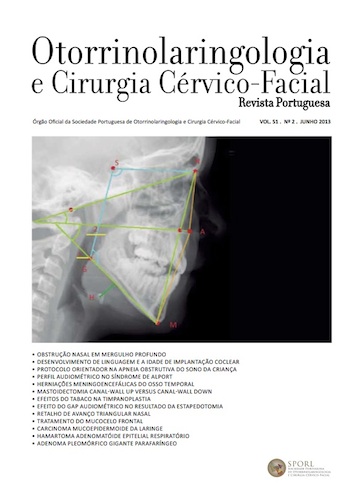Tradução e validação da "brief version of the Questionnaire of Olfactory Disorders-Negative Statements" para a língua portuguesa
DOI:
https://doi.org/10.34631/sporl.2039Palavras-chave:
Olfato, Rinite, Sinusite, Qualidade de vida, Inquéritos, QuestionáriosResumo
Objetivo: A disfunção olfativa pode levar a ansiedade e sintomas depressivos. Desde o início da pandemia COVID-19 que assistimos a um maior reconhecimento da disfunção olfativa, surgindo a necessidade de existirem questionários estandardizados que permitam compreender as dificuldades e aprender a lidar com as expetativas dos nossos pacientes.
Material e métodos: Tradução e validação da brief version of the Questionnaire of Olfactory Disorders-Negative Statements (bvQOD-NS) para português.
Resultados: Trinta pacientes com disfunção olfativa confirmada por testes psicofísicos cumpriram os critérios de inclusão. A consistência interna do bvQOD-NS medido com Cronbach α foi 0.589. O coeficiente de correlação intraclasse foi 0.925 (intervalo de confiança 95%: 0.841-0.964), sendo indicativo de uma excelente reprodutibilidade de resultados.
Conclusões: A língua portuguesa é a sétima mais falada em todo o mundo. A versão portuguesa do bvQOD-NS permite uma avaliação rápida e válida do impacto da disfunção olfativa na qualidade de vida dos pacientes, bem como a comparação entre séries, fornecendo informação importante à comunidade médica.
Downloads
Referências
Stevenson RJ. An initial evaluation of the functions of human olfaction. Chem Senses. 2010 Jan;35(1):3-20. doi: 10.1093/chemse/bjp083.
Croy I, Nordin S, Hummel T. Olfactory disorders and quality of life - an updated review. Chem Senses. 2014 Mar;39(3):185-94. doi: 10.1093/chemse/bjt072
Schäfer L, Schriever VA, Croy I. Human olfactory dysfunction: causes and consequences. Cell Tissue Res. 2021 Jan;383(1):569-579. doi: 10.1007/s00441-020-03381-9.
Hummel T, Whitcroft KL, Andrews P, Altundag A, Cinghi C, Costanzo RM. et al. Position paper on olfactory dysfunction. Rhinol Suppl. 2017 Mar;54(26):1-30. doi: 10.4193/Rhino16.248.
Boscolo-Rizzo P, Hummel T, Hopkins C, Dibattista M, Menini A, Spinato G. et al. High prevalence of long-term olfactory, gustatory, and chemesthesis dysfunction in post-COVID-19 patients: a matched case-control study with one-year follow-up using a comprehensive psychophysical evaluation. Rhinology. 2021 Dec 1;59(6):517-527. doi: 10.4193/Rhin21.249.
Frasnelli J, Hummel T. Olfactory dysfunction and daily life. Eur Arch Otorhinolaryngol. 2005 Mar;262(3):231-5. doi: 10.1007/s00405-004-0796-y.
Simopoulos E, Katotomichelakis M, Gouveris H, Tripsianis G, Livaditis M, Danielides V. Olfaction-associated quality of life in chronic rhinosinusitis: Adaptation and validation of an olfaction-specific questionnaire. Laryngoscope. 2012 Jul;122(7):1450-4. doi: 10.1002/lary.23349.
Mattos JL, Edwards C, Schlosser RJ, Hyer M, Mace JC, Smith TL. et al. A brief version of the questionnaire of olfactory disorders in patients with chronic rhinosinusitis. Int Forum Allergy Rhinol. 2019 Oct;9(10):1144-1150. doi: 10.1002/alr.22392.
Mattos JL, Bodner TE, Mace JC, Schlosser RJ, Beswick DM, Ramakrishnan VR. et al. Psychometric properties of the brief version of the questionnaire of olfactory disorders in patients with chronic rhinosinusitis. Int Forum Allergy Rhinol. 2021 Oct;11(10):1436-1442. doi: 10.1002/alr.22800.
Hopkins C. Two years of COVID-19 – smell is still stealing the spotlight on the rhinology stage. Rhinology. 2022 Apr 1;60(2):81. doi: 10.4193/Rhin22.902.
Cain WS, Gent JF, Goodspeed RB, Leonard G. Evaluation of olfactory dysfunction in the Connecticut Chemosensory Clinical Research Center. Laryngoscope. 1988 Jan;98(1):83-8. doi: 10.1288/00005537-198801000-00017.
Hummel T, Sekinger B, Wolf SR, Pauli E, Kobal G. “Sniffin’sticks”: olfactory performance assessed by the combined testing of odor identification, odor discrimination and olfactory threshold. Chem Senses. 1997 Feb;22(1):39-52. doi: 10.1093/chemse/22.1.39.
Ribeiro JC, Simões J, Silva F, Silva ED, Hummel C, Hummel T. et al. Cultural adaptation of the Portuguese version of the “Sniffin’ Sticks” smell test: reliability, validity, and normative data. PLoS One. 2016 Feb 10;11(2):e0148937. doi: 10.1371/journal.pone.0148937.
Guillemin F, Bombardier C, Beaton D. Cross-cultural adaptation of health-related quality of life measures: literature review and proposed guidelines. J Clin Epidemiol. 1993 Dec;46(12):1417-32. doi: 10.1016/0895-4356(93)90142-n.
Zou L, Haehner A, Menzel S, Gunder N, Hummel T. Reliability and validity of a brief version of the Questionnaire of Olfactory Disorders (brief QOD) in patients with olfactory dysfunction. Rhinology. 2022 Feb 1;60(1):56-62. doi: 10.4193/Rhin21.059.
Chiesa-Estomba CM, Lechien JR, Calvo-Henríquez C, Mayo M, Maldonado B, Maza J. et al. Translation and validation of the short version of the Questionnaire of Olfactory Disorders–Negative Statements to Spanish. Am J Otolaryngol. 2021 Jan-Feb;42(1):102775. doi: 10.1016/j.amjoto.2020.102775.
Leclercq C, Chiesa-Estomba CM, Horoi M, Le Bon SD, Hans S, Distinguin L. et al. Validity and reliability of the French short version of the Questionnaire of Olfactory Disorders-Negative Statements (sQOD-NS). Ear Nose Throat J. 2021 Aug 31;1455613211032004. doi: 10.1177/01455613211032004.
The World Factbook 2021 [Internet]. Washington DC: Central Intelligence Agency; 2021 [accessed 20 October 2022]. Available from: https://www.cia.gov/the-world-factbook/about/archives/2021/.
de Vilhena D, Duarte D, Lopes G. Sino-Nasal Outcome Test-22: translation, cultural adaptation and validation in Portugal. Clin Otolaryngol. 2016 Feb;41:21-24. doi: 10.1111/coa.12465.
Cerejeira R, Veloso-Teles R, Lousan N, Pinto Moura C. The Portuguese version of the RhinoQOL Questionnaire: validation and clinical application. Braz J Otorhinolaryngol. 2015 Nov-Dez;81(6):630-635. doi: 10.1016/j.bjorl.2015.08.015.
Moraes JMM, Moraes CHC, Souza AAL, Alvarenga MDS. Food choice motives among two disparate socioeconomic groups in Brazil. Appetite. 2020 Dec 1;155:104790. doi: 10.1016/j.appet.2020.104790.
Lechien JR, Chiesa-Estomba CM, De Siati DR, Horoi M, Le Bon SD, Rodriguez A. et al. Olfactory and gustatory dysfunctions as a clinical presentation of mild-to-moderate forms of the coronavirus disease (COVID-19): a multicenter European study. Eur Arch Otorhinolaryngol. 2020 Aug;277(8):2251-2261. doi: 10.1007/s00405-020-05965-1.
Karamali K, Elliott M, Hopkins C. COVID-19 related olfactory dysfunction. Curr Opin Otolaryngol Head Neck Surg. 2022 Feb 1;30(1):19-25. doi: 10.1097/MOO.0000000000000783.
Saniasiaya J, Prepageran N. Impact of olfactory dysfunction on quality of life in coronavirus disease 2019 patients: a systematic review. J Laryngol Otol. 2021 Nov;135(11):947-952. doi: 10.1017/S0022215121002279.
Coelho DH, Reiter ER, Budd SG, Shin Y, Kons ZA, Costanzo RM. Quality of life and safety impact of COVID-19 associated smell and taste disturbances. Am J Otolaryngol. 2021 Jul-Aug;42(4):103001. doi: 10.1016/j.amjoto.2021.103001.
Downloads
Publicado
Como Citar
Edição
Secção
Licença
Direitos de Autor (c) 2023 Os autores mantêm os direitos de autor deste artigo.

Este trabalho encontra-se publicado com a Licença Internacional Creative Commons Atribuição-CompartilhaIgual 4.0.






